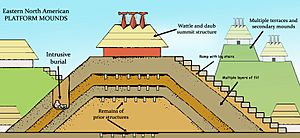Long Swamp Site facts for kids
| Location | Ball Ground, Georgia, Cherokee County, Georgia, United States |
|---|---|
| Region | Cherokee County, Georgia |
| Coordinates | 34°19′10.49″N 84°20′31.56″W / 34.3195806°N 84.3421000°W |
| History | |
| Founded | 1100 CE |
| Abandoned | early 1600s |
| Periods | Late Etowah Phase (1100 to 1200 CE) |
| Cultures | South Appalachian Mississippian culture |
| Site notes | |
| Excavation dates | 1938, 1940s, 2003-2004, |
| Archaeologists | Robert Wauchope, Lewis H. Larson |
The Long Swamp Site (also known as 9 CK 1) is an ancient place in Cherokee County, Georgia, United States. It covers about 4 acres (1.6 hectares). This important archaeological site is found on the north bank of the Etowah River.
Long Swamp was once a busy village built by people of the South Appalachian Mississippian culture. This culture was known for building large earthen mounds. The site includes a village area, a protective fence called a palisade, and a special platform mound.
Contents
What Was Found at Long Swamp?
The Long Swamp Site is located on flat land next to the Etowah River. It sits near where the river meets Long Swamp Creek.
When People Lived There
People lived at the Long Swamp Site during two different periods long ago. The first time was during the Early Mississippian period. This was around 1100 to 1200 CE (Common Era). Later, people returned to live there again during a period called the Mayes and Brewster Phases.
Buildings and Features
The large platform mound at Long Swamp was built in three main stages. Each stage added new layers, making a total of ten different layers. The mound started as a circular building used for burials.
- First Stage: A mound about 55 centimeters (1.8 feet) tall was built. A structure sat on top of it. This building was round, about 6.8 meters (22 feet) across. It had a clay floor and a fireplace.
- Later Stages: More layers were added on top. The mound eventually reached a height of about 3 to 4 meters (10 to 13 feet). It's not clear if the very top also had a building, as it was damaged over time.
After the last layer was added, the entire area was flooded. This left a layer of mud covering the site. No new layers were added to the mound during the second time people lived there.
Archaeologists also found remains of other buildings at the site.
- Protective Wall: During the first period of occupation, there was a palisade (a strong fence made of tall posts) and a ditch around the village. This helped protect the people living inside.
- Large Building: A big rectangular building was found. It measured about 7 by 8 meters (23 by 26 feet). It was made of posts and had a central fireplace and storage pits. This building was found to have been burned down.
- Borrow Pits: Outside the palisade, there were "borrow pits." These were places where people dug up soil to use for building the mound or other structures.
- Circular Structure: On a higher part of the site, overlooking the river, a large circular building was discovered. It was about 6 meters (20 feet) across and had 22 posts forming its outer walls. It had an entrance about 1 meter (3.3 feet) wide on its southeast side. A walkway extended from the building. This structure also showed signs of having been burned. Scientists used carbon dating to figure out that this building was used around 1610 CE.
How We Know About Long Swamp
Archaeologists have studied the Long Swamp Site many times.
- In 1938, Robert Wauchope did some digging.
- In 1949, Lewis H. Larson also excavated parts of the site. He worked under the direction of Arthur Randolph Kelly.
- More recently, in 2003 and 2004, the site was surveyed. Then, in the late 2000s, Edwards-Pitman Environmental, Inc. did a very detailed excavation. These studies help us understand the history of the people who lived there long ago.



